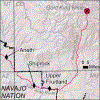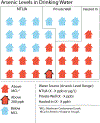Using environmental health dialogue in a Diné-centered approach for individualized results reporting in an environmental exposure study following the Gold King Mine Spill
- PMID: 37211184
- PMCID: PMC10411314
- DOI: 10.1016/j.envres.2023.116196
Using environmental health dialogue in a Diné-centered approach for individualized results reporting in an environmental exposure study following the Gold King Mine Spill
Abstract
Background: On August 5, 2015, the Gold King Mine Spill (GKMS) resulted in 3 million gallons of acid mine drainage spilling into the San Juan River impacting the Diné Bikeyah (traditional homelands of the Navajo people). The Gold King Mine Spill Diné Exposure Project was formed to understand the impacts of the GKMS on the Diné (Navajo). Reporting individualized household results in an exposure study is becoming more common; however, materials are often developed with limited community input with knowledge flowing in one direction - from researcher to participant. In this study we examined the development, dissemination, and evaluation of individualized results materials.
Methods: In August 2016, Navajo Nation Community Health Representatives (Navajo CHRs) sampled household water, dust, and soil, and resident blood and urine for lead and arsenic, respectively. From May-July 2017, iterative dialogue with a wide range of community partners and a community focus groups guided the development of a culturally-based dissemination process. In August 2017, Navajo CHRs reported individualized results and they surveyed the participants on the report-back process at that time.
Results: All of the 63 Diné adults (100%) who participated in the exposure study received their results by a CHR in person and 42 (67%) completed an evaluation. Most of those participants (83%) were satisfied with the result packets. Respondents ranked the individual and overall household results as the most important information they received (69% and 57%, respectively), while information on metals exposures and their health effects were the least helpful.
Conclusions: Our project illustrates how a model of environmental health dialogue, defined by iterative, multidirectional communication among Indigenous community members, trusted Indigenous leaders, Indigenous researchers, non-Indigenous researchers, can improve reporting individualized study results. Findings can inform future research to encourage multi-directional environmental health dialogue to craft more culturally responsive and effective dissemination and communication materials.
Keywords: Diné (Navajo); Disaster; Environment health dialogue; Environmental justice; Gold king mine spill; Indigenous health; Report back of research results.
Copyright © 2023 Elsevier Inc. All rights reserved.
Conflict of interest statement
Declaration of competing interest The authors declare that they have no known competing financial interests or personal relationships that could have appeared to influence the work reported in this paper.
Figures







References
-
- Absolon KE (2011). Kaandossiwin: How We Come to Know Halifax, Nova Scotia, Canada: Fernwood Publishing.
-
- Adams C, Brown P, Morello-Frosch R, Brody JG, Rudel R, Zota A, … Pattonand S (2011). Disentangling the exposure experience: The roles of community context and report-back of environmental exposure data. Journal of Health and Social Behavior, 52(2), 180–196. 10.1177/0022146510395593 - DOI - PMC - PubMed
-
- Barrett ES, Sathyanarayana S, Janssen S, Redmon JB, Nguyen RHN, Kobrosly R, & Swan SH (2014). Environmental health attitudes and behaviors: Findings from a large pregnancy cohort study. European Journal of Obstetrics Gynecology and Reproductive Biology, 176(1), 119–125. 10.1016/j.ejogrb.2014.02.029 - DOI - PMC - PubMed
Publication types
MeSH terms
Substances
Grants and funding
LinkOut - more resources
Full Text Sources

